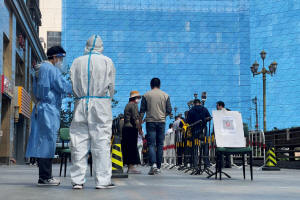Beijing steps up COVID curbs as virus spreads in China
 Send a link to a friend
Send a link to a friend
 [May 04, 2022] BEIJING/SHANGHAI
(Reuters) - Beijing shut scores of metro stations and bus routes and
extended COVID-19 curbs on many public venues on Wednesday, focusing
efforts to avoid the fate of Shanghai, where millions have been under
strict lockdown for more than a month. The central city of Zhengzhou
earlier also announced restrictions, joining dozens of big population
centres under some form of lockdown as China seeks to eliminate a virus
believed to have first emerged in Wuhan city in late 2019. But that
uncompromising battle is undermining its growth and hurting
international companies invested there, data shows, and has also fuelled
rare public outbursts of discontent. With dozens of new cases a day,
Beijing is hoping mass testing will find and isolate the virus before it
spreads. Twelve of 16 city districts held the second of three rounds of
tests this week. The city of 22 million on Wednesday shut more than 60
subway stations, about 15% of the network, and 158 bus routes, service
providers said, most in the Chaoyang district at the epicentre of
Beijing's outbreak. Beijing officials also said closures of schools,
restaurants, gyms and entertainment venues - as well as some businesses
and residential buildings - would extend beyond the April 30- May 4
Labour Day break, without giving a timeframe. [May 04, 2022] BEIJING/SHANGHAI
(Reuters) - Beijing shut scores of metro stations and bus routes and
extended COVID-19 curbs on many public venues on Wednesday, focusing
efforts to avoid the fate of Shanghai, where millions have been under
strict lockdown for more than a month. The central city of Zhengzhou
earlier also announced restrictions, joining dozens of big population
centres under some form of lockdown as China seeks to eliminate a virus
believed to have first emerged in Wuhan city in late 2019. But that
uncompromising battle is undermining its growth and hurting
international companies invested there, data shows, and has also fuelled
rare public outbursts of discontent. With dozens of new cases a day,
Beijing is hoping mass testing will find and isolate the virus before it
spreads. Twelve of 16 city districts held the second of three rounds of
tests this week. The city of 22 million on Wednesday shut more than 60
subway stations, about 15% of the network, and 158 bus routes, service
providers said, most in the Chaoyang district at the epicentre of
Beijing's outbreak. Beijing officials also said closures of schools,
restaurants, gyms and entertainment venues - as well as some businesses
and residential buildings - would extend beyond the April 30- May 4
Labour Day break, without giving a timeframe.

Residents were encouraged to work from home from Thursday, rather than
return to offices where possible.Late on Tuesday Zhengzhou, home to 12.6
million people and a factory of Apple's iPhone manufacturer Foxconn,
announced work-from-home and other COVID curbs for the coming week.
Foxconn said on Wednesday it was continuing production there.
PROTEST VIA BLOCKCHAIN
In Shanghai, meanwhile, a full lockdown remains in force. After more
than a month, most people in mainland China's biggest city still
cannot leave their housing compounds. Some have benefited from a
tentative easing of restrictions since Sunday, with usually just one
member of a household allowed out for a stroll and grocery shopping.
Latest data showed Shanghai found 63 new cases outside areas under
the strictest curbs, suggesting it has a way to go before reaching
the goal of no cases for several days for curbs to ease
significantly. The isolation has led to a cat-and-mouse game between
censors and social media users striving to keep evidence of the
hardship circulating. Some have turned to blockchain technology to
protect videos, photos and artwork on the topic from deletion. Such
acts of defiance are awkward for the ruling Communist Party in a
year in which President Xi Jinping is expected to secure a third
leadership term.
[to top of second column] |

Workers in protective suits stand next to people lining up a
makeshift nucleic acid testing site during a mass testing for the
coronavirus disease (COVID-19) in Chaoyang district of Beijing,
China May 4, 2022. REUTERS/Alessandro Diviggiano

GROWTH FORECAST CUT Authorities say their zero-COVID policy
aims to save lives, pointing to the millions killed by the virus
outside China, where many countries are adopting a "live with COVID"
strategy amid spreading infections. But the policy is hurting
domestic consumption and output, disrupting global supply chains and
shrinking revenues for international brands including Apple, Gucci
parent Kering and Taco Bell-owner Yum China. Capital Economics
estimated COVID had spread to areas generating 40% of China's output
and 80% of its exports, while Fitch Ratings cut its 2022 GDP growth
forecast to 4.3% from 4.8%, well below China's official 5.5% target.
Numerous factories were shut after Shanghai went into lockdown from
March. While some have started reopening, getting workers back and
unsnarling supply chains has proven difficult. In the city's Lingang
free trade zone area, 252 firms, or 52% of the total, had resumed
work as of May 3, the Xinhua news agency reported. Authorities were
subsidising the screening of workers for COVID, and providing rent
relief, it said. International trade is also facing disruption. A
Royal Bank of Canada study found a fifth of the global container
ship fleet was stuck in ports. At Shanghai's port, 344 ships were
awaiting berth, a 34% increase over the past month. Shipping
something from a warehouse in China to one in the United States
takes 74 days longer than usual, the study said.
(Reporting Aizhu Chen, Hou Xiangming, Brenda Goh and the Beijing and
Shanghai bureaus; Writing by Marius Zaharia; Editing by Robert
Birsel and John Stonestreet)
[© 2022 Thomson Reuters. All rights
reserved.]
This material may not be published,
broadcast, rewritten or redistributed.
Thompson Reuters is solely responsible for this content.
 |